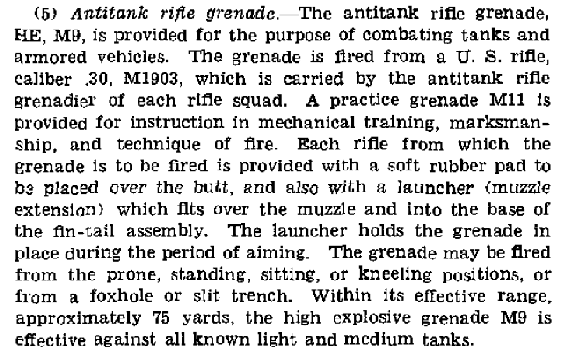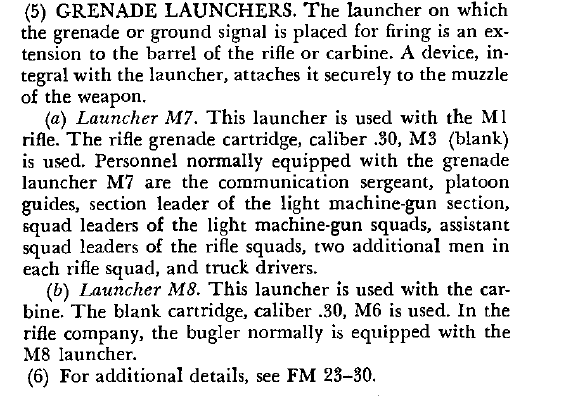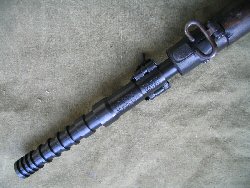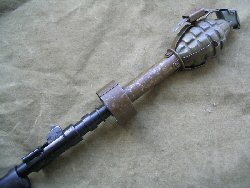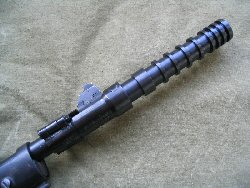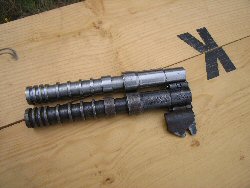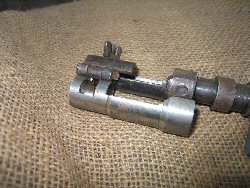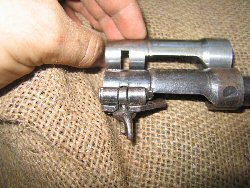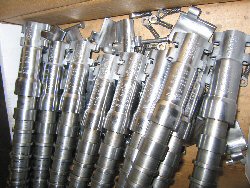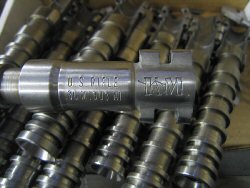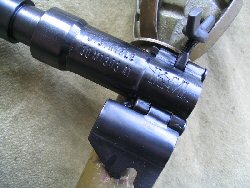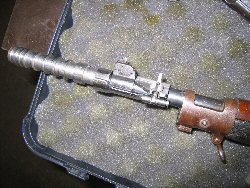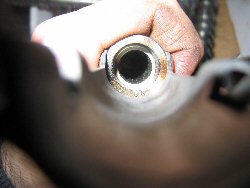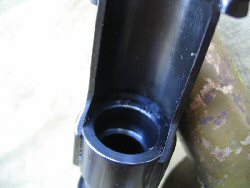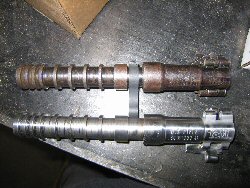Reproduction Grenade Launcher, M1 for the M1903 Springfield Rifle
Written: Dec 2008
Author: Chris Guska
Historical Background:
One of the underrepresented items in the reenactment community is the M1 Rifle Grenade Launcher attachment for the 1903 Springfield Rifle. Prior to the introduction of the Bazooka, the US Army's primary infantry anti-armor weapon was the M9 High Explosive Anti Tank Rifle Grenade to be utilized with the 1903 Springfield Rifle. Each rifle squad in the infantry company was to have the assistant squad leader equipped with the 1903 Springfield Rifle and M1 Rifle Grenade Launcher for anti-tank defense. Additionally, early war TO&E (Tables of Organization and Equipment) had allowances for the M1 Rifle Grenade Launcher in Heavy Weapons companies and across the division in its entirety.
(Extracts from FM 7-10, 1942 Edition)Not until 1944 did the Army develop and field in sizeable numbers the M7 Rifle Grenade Launcher for the M1 Garand rifle. The M7 launcher saw significant issue for the Normandy invasion and the breakout.
(Extract from FM 7-10, 1944 Edition)The development and use of rifle grenades with the M1 Garand proved to be problematic due to the gas operated action of the Garand and attrition of launchers being lost. The M1 Garand required the user to attach the M7 launcher prior to using the rifle grenade, disabling the gas system and semi automatic fire, single load a rifle grenade blank, then remove the launcher after firing to restore semi automatic function. Early experiences in Normandy showed that many launchers were being removed after firing and left behind in the heat of combat. This constant removal of the launcher resulted in rapid depletion of stocks of the M7 launcher, in some cases forcing the M1 launcher back into service.
Due to the shortcomings of the M7 launcher for the M1 Garand and combat losses, the M1903 Springfield and M1 launcher continued to be highly utilized and popular among the troops. GI's favored the M1 launcher due to the ability of the user to fire the weapon normally without having to affix and remove the rifle grenade launcher as well as very quickly and easily single load rifle grenade blanks.
The M1 Launcher was declared substitute standard during the war and obsolete at the end of the war. Most of the launchers were sold to foreign governments or scrapped outright with very few hitting the surplus market.For more information on the Launcher, M1 for the M1903 Springfield Rifle: Variants and Details
Today:
At the Fort Indiantown GAP reenactment in January of 2007 I noticed a M1 Rifle Grenade Launcher for sale on Tom Arter's (A&A Militaria) table. Tom was asking $695.00 for a good condition launcher, without any accessories or positioning clips. I first noticed the launcher on Thursday afternoon and by Friday morning it had been sold. Seeing that it sold for what I thought at the time to be an astronomical price, I went home and started checking the market to see the current prices. As of the summer of 2008, it was not uncommon to see fair to damaged M1 launchers sell for in excess of $800.00 when they came up for sale which far exceeded the price of the average 1903 Springfield Rifle.
Until the summer of 2008, there were no known high quality reproductions available in quantity for any price. Individual hobbyists have created some workable “reproductions” or similarly styled devices, but as of the date of this writing I am unaware of any significant quantity of true copies of the original item. Having access to an original 2nd pattern M1 Launcher from the 90th IDPG collection, I set about to making a faithful reproduction in quantity for the reenactor market at an affordable price.
The Reproduction:
There were 45 reproduction launchers made - no more, no less. All have been sold and are long gone, in the loving hands of their Reenactor and Living Historian owners. There is no secret stash, I only have one for myself, and I have no plans to make any more of them.
The launchers were made, advertised and sold as display pieces, not certified or intended for actual use. Buyers assumed any and all risks of ownership and use by purchasing them and were responsible for knowing and adhering to any applicable laws related to the product.
The reproduction M1 Launcher for the Springfield Rifle was a precision product that allowed the reenactor to display the piece as it would have been used during the war. The launcher was made such that it would accept any WWII USGI Rifle Grenade or Adapter as originally issued.I cannot thank the gentleman and craftsman who I teamed up with on this project enough for his experience, thought, work and time to see these launchers to completion. Thanks Troy!
The M1 launcher proved fairly difficult to accurately replicate. From a glance, the launchers are deceptively simple - but when it comes down to producing an acceptably detailed reproduction - very few have succeeded.
The launcher tube itself was CNC Lathe turned out of 4140 for accuracy, consistency and speed of production. This was just about the only "easy" portion of the whole project.
The most difficult portion of the launcher was the clamp assembly. Originally the clamp assembly was a multi-step stamping from drawing quality steel. The clamp body exhibits a stepped reduction in size with a radiused edge.The clamp body was turned and profiled from 4130 tubing then milled, slotted and bent into its final shape for the first 20 launchers.
The second batch of 25 launchers utilized carefully welded on hinges rather than the time consuming and inconsistently shaped bent hinges. Careful inspection of the hinge area will reveal the construction differences between these reproductions and the originals. Additionally in the second batch of 25 launchers, I made a limited number (7) short door variants of the M1 launcher.
Prior to bending or welding on the hinge barrels, the body was stamped with the nomenclature and K&M logo. I believe that originally these markings were roll stamped onto the clamp body after it had been fully formed. For my reproductions I utilized custom sharp face concave marking dies for both the logo as well as nomenclature. The unfinished clamp body and die were tensioned in a 20 ton arbor press then struck to apply the marking. During the marking process, the nomenclature die was damaged and repaired several times, ultimately compromising the die.
The launchers were lightly buffed on a wire wheel then sent out for black oxide finishing. Rather than a do it yourself (incorrect) zinc phosphate or home "bluing" process - I went for the more durable and more correct hot bluing (black oxide) finish.
Identifying Features:
These reproductions have several subtle identifying features to distinguish them from original specimens.
1.) Before final assembly and welding, the face of the launcher tube that sits inside the clamp assembly was stamped with my initials, CG, and the gentleman who I worked with on these launchers - KTT. These initials were applied prior to assembly and commercial hot black oxide finishing. Due to the placement of the initials, they will be very difficult to remove without showing evidence of doing so.2.) The dimensions of the K&M lightning bolt logo were slightly oversized. This was not a deliberate move to make an additional identifying feature, but rather a gaff on the part of the die maker. I had a single custom concave sharp face steel marking die made for the K&M logo - and either I did not specify the correct height or the die maker / engraver screwed something up. By the time I had realized the error, I decided against having another die made and utilizing this as an added feature for future identification.
3.) Careful examination of the hinge barrels will reveal that they are either welded on, or have a weld to close and strengthen them on the “bent” first run launchers.
Closing Thoughts:
Surely there will be collectors who decry my efforts and brand me as a “humper” for making these reproductions. I have made every attempt to produce a quality product, with the Reenactor market specifically in mind, such that it allows history to be represented at an affordable price without destroying original artifacts in the process. I took great thought in how to mark these as reproductions and build in “flaws” such that the discerning collector could immediately recognize my product as a reproduction in short order. This page is yet another tool for collectors and reenactors to identify my product for what it is. To those who already own one of my products, thank you for supporting a hobbyist. To those who may own one of these in the future, enjoy it for what it is and never represent it as something that it is not. To those never able to own one, I encourage you to take it upon yourself to research, create and improve the hobby and the lives of those around you.
The author with his toys, August 2008, Dennison, Ohio.
90th IDPG Projects




